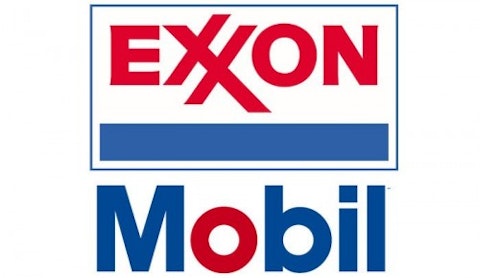Following two years of underwhelming world GDP growth, the OECD forecasts that world real gross domestic product will increase by more than 3% in 2013 and by 4% in 2014. As global energy demand is tightly linked to economic growth, now is an exciting time to consider investments in some of the world’s largest energy suppliers: Exxon Mobil Corporation (NYSE:XOM), Chevron Corporation (NYSE:CVX) and BP plc (ADR) (NYSE:BP).
Even more consequential in the long-run for the energy industry than a quickening global economic recovery are long-term energy use trends in the developing world. While energy use by OECD member countries has been relatively flat from 2000 to 2013 (and is expected to remain so through 2020), as a result of population growth and economic expansion, energy use in non-OECD countries (consisting of much of Asia, Africa and South America) is expected to double between 2000 and 2020. Although the precise arc of energy demand growth is unpredictable, long-term demographic and economic factors in developing countries make clear that energy suppliers will be contending over a growing consumer market in the coming years.
While many people concerned about global climate change hope that technological innovation in the field of energy efficiency and/or increased use of alternative energy sources may alter energy use forecasts, such developments are unlikely to impair the operations of the energy suppliers this article discusses. Exxon Mobil Corporation (NYSE:XOM), Chevron Corporation (NYSE:CVX) and BP plc (ADR) (NYSE:BP) are each heavily diversified with large investments in the development of energy efficient products and in alternative energy sources.
For example, Chevron’s Energy Solutions unit is directly involved in hundreds of projects, some valued at over $100 million, where it is experimenting with energy efficient systems that it hopes may one day be scaled and brought to competitive markets.
In regard to alternative energy sources, the development expected to most significantly alter the energy landscape in the coming years is the growth of natural gas extraction through hydraulic fracturing, or “fracking”. Exxon Mobil Corporation (NYSE:XOM), Chevron Corporation (NYSE:CVX) and BP plc (ADR) (NYSE:BP) all draw on diverse sources to bring energy to market and each has made substantial investments in the extraction of natural gas. In just this past month Exxon Mobil Corporation (NYSE:XOM)’s and Chevron’s management have had to defend their extensive fracking practices from activist shareholders. None of these companies is likely to be left behind by a fracking boom.
The case for Chevron and ExxonMobil
Among the three energy giants discussed here, each of which is likely to benefit from the macroeconomic trends discussed in the previous section, Chevron is the most attractive investment based on its price stability, growth history and dividend yield.
In regard to stock price stability, Exxon Mobil Corporation (NYSE:XOM) and Chevron Corporation (NYSE:CVX) have a decided advantage over volatile BP plc (ADR) (NYSE:BP). Since the 2010 Deepwater Horizon oil spill in the Gulf of Mexico, BP’s stock price has been extensively affected by unpredictable legal battles over the company’s criminal and civil liability.
ExxonMobil and Chevron each have a beta around 1, while BP’s legal uncertainties have resulted in a beta over 2. Despite having already paid over $30 billion to resolve claims arising from the Deepwater spill, BP plc (ADR) (NYSE:BP) is still involved in civil litigation over the Clean Water Act that could cost it another $17 billion. Although ExxonMobil and Chevron Corporation (NYSE:CVX) each carry their own legal risk (most notably, ExxonMobil in regard to LGBT discrimination and Chevron in relation to environmental degradation in Ecuador), the magnitude and strength of the claims against them pale in comparison to the legal risk associated with BP.
Chevron’s growth history and dividend yield make it a superior investment to the larger, slower growing, and lower-dividend-yielding ExxonMobil. Despite a 4.5% decrease in earnings per share in Q1 2013, Chevron Corporation (NYSE:CVX) has a stronger recent history of earnings growth than ExxonMobil. Between 2007 and 2012 Chevron’s earnings per share grew 35%, while Exxon Mobil Corporation (NYSE:XOM)’s per share earnings grew only 25%.
Though past growth is no guarantee of future success, Chevron’s growth history highlights the fact that, with a market capitalization of roughly half of ExxonMobil’s $400 billion, Chevron has more opportunity for growth than ExxonMobil and it has been more successful in recent years than ExxonMobil has in seizing its growth opportunities. Moreover, due in part to a slightly higher payout ratio than ExxonMobil, despite being a smaller company, Chevron historically pays a higher dividend than ExxonMobil: Chevron’s five year average dividend yield is 3.3% to ExxonMobil’s 2.3%.
The call is Chevron
With global trends pointing to positive growth in the energy demand in the medium and long-term, large, diverse energy suppliers such as ExxonMobil, Chevron Corporation (NYSE:CVX) and BP plc (ADR) (NYSE:BP) offer enticing investment opportunities. Among these companies, Chevron’s stock price stability, strong growth and high dividend yield make it the most attractive buy.
The article This Oil Company Offers Growth, Income and Stability originally appeared on Fool.com and is written by Colin Tweel.
Colin Tweel has no position in any stocks mentioned. The Motley Fool recommends Chevron. Colin is a member of The Motley Fool Blog Network — entries represent the personal opinion of the blogger and are not formally edited.
Copyright © 1995 – 2013 The Motley Fool, LLC. All rights reserved. The Motley Fool has a disclosure policy.





